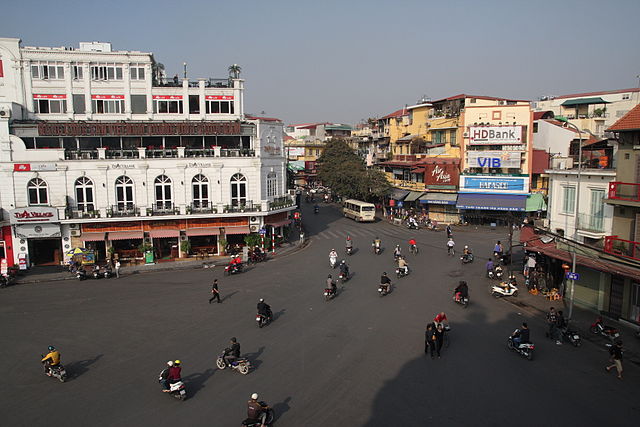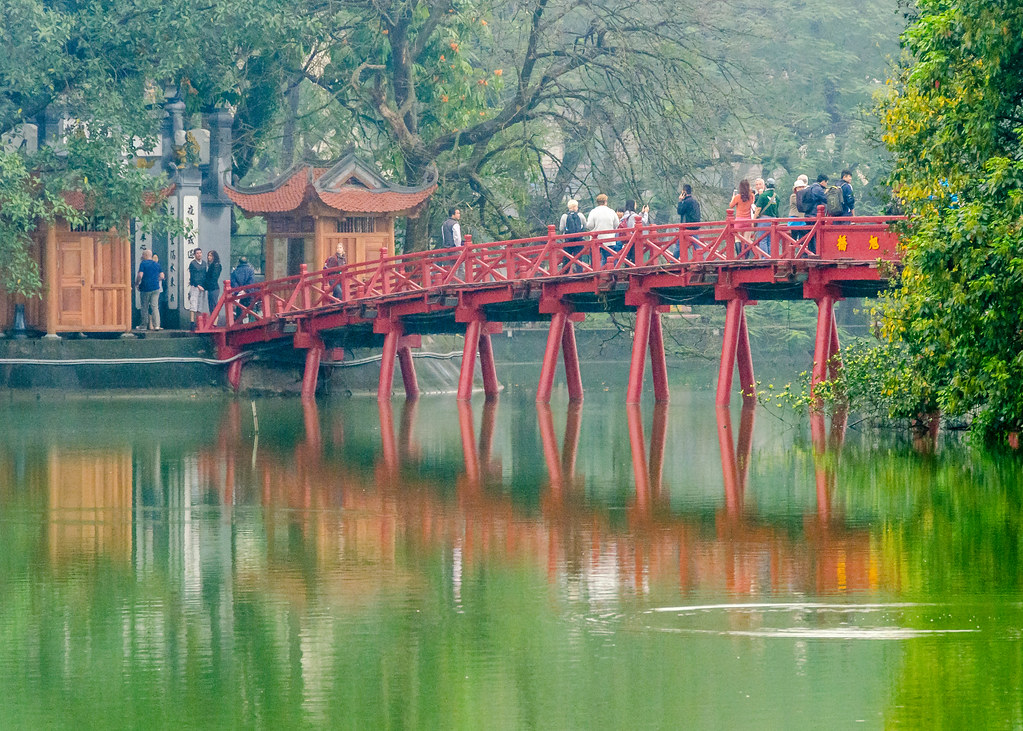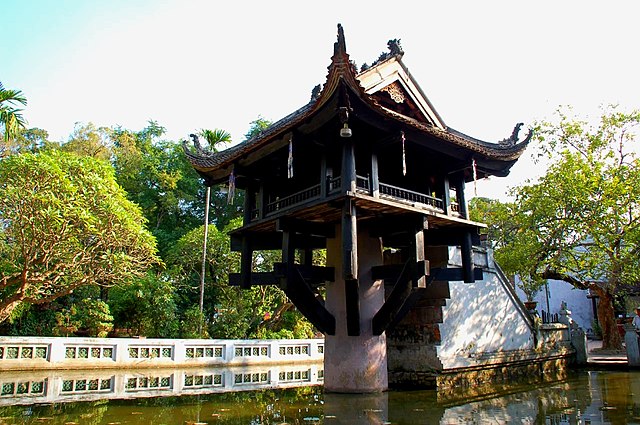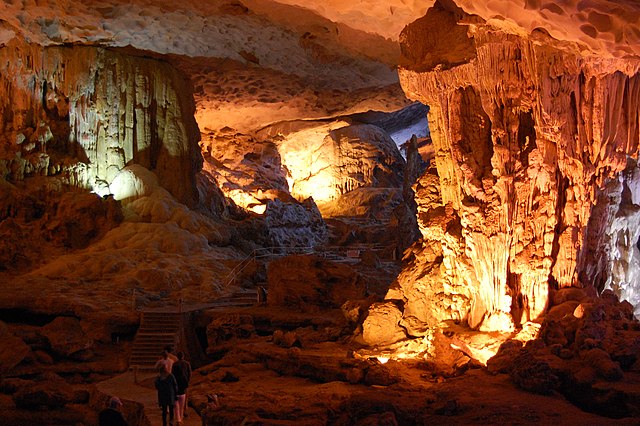Although many westerners still imagine Vietnam through the lens of war, it is in reality a country filled with natural beauty and rich history. Hanoi, the country's capital, is a city of lakes, shaded boulevards and leafy parks. People have settled here along the Red River for a thousand years. East of Hanoi is the picturesque World Heritage site Ha Long Bay. Its stunning landscape and emerald waters attract artists and photographers from all around the world.
Hà Nội, Hanoi
The Old Quarter, near Hoan Kiem Lake, has the original street layout and architecture of old Hanoi. At the beginning of the 20th century the city consisted of only about 36 streets, most of which are now part of the old quarter. Each street then had merchants and households specializing in a particular trade, such as silk or jewelry. The street names nowadays still reflect these specializations, although few of them remain exclusively in their original commerce. The area is famous for its small artisans and merchants, including many silk shops. Local cuisine specialties as well as several clubs and bars can be found here also. A night market (near Dong Xuan Market) in the heart of the district opens for business every Friday, Saturday, and Sunday evening with a variety of clothing, souvenirs and food.
Ngoc Son Temple, also known as the Temple of the Jade Mountain, is located on Hoan Kiem Lake. It was built on the Jade Islet and dedicated to Confucian and Taoist philosophers. The Hoan Kiem lake is one of the major scenic spots in the city and serves as a focal point for its public life.
Under French rule, as an administrative centre for the French colony of Indochina, the French colonial architecture style became dominant, and many examples remain today, such as St Joseph Cathedral. It is a late 19th-century Gothic Revival (Neo-Gothic style) church that serves as the cathedral of the Roman Catholic Archdiocese of Hanoi.
The Temple of Literature (Vietnamese: Van Mieu) is a Temple of Confucius in Hanoi. The temple hosts the Imperial Academy, Vietnam's first national university. The temple was built in 1070 at the time of Emperor Ly Thanh Tong. It is one of several temples in Vietnam which is dedicated to Confucius, sages and scholars. The various pavilions and halls are places where ceremonies, study sessions and the exams took place. The temple is featured on the back of the 100,000 Vietnamese dong banknote.
Hanoi
Ba Dình Square is where president Ho Chi Minh read the Proclamation of Independence of the Democratic Republic of Vietnam on September 2, 1945. It is named after the Ba Dình Uprising, an anti-French rebellion that occurred in Vietnam in 1886–1887 as part of the Can Vuong movement. The square remains a major site of tourism and pilgrimage.
The One Pillar Pagoda is a historic Buddhist temple in Hanoi. It is regarded alongside the Perfume Temple, as one of Vietnam's two most iconic temples. The temple was originally built by Emperor Ly Thai Tong, who ruled from 1028 to 1054. The temple is built of wood on a single stone pillar, and it is designed to resemble a lotus blossom, which is a Buddhist symbol of purity. In 1954, the French Union forces destroyed the pagoda before withdrawing from Vietnam after the First Indochina War. The current temple was rebuilt afterwards.
The Ho Chi Minh Mausoleum is a large memorial located in the center of Ba Dinh Square, which is the place where Ho Chi Minh, Chairman of the Communist Party of Vietnam from 1951 until his death in 1969, read the Declaration of Independence establishing the Democratic Republic of Vietnam. The embalmed body of Ho Chi Minh is preserved in the cooled, central hall of the mausoleum. The mausoleum's portico has the words "Chu tich Ho Chi Minh" (Chairman Ho Chi Minh) inscribed across it. The banner beside says "Nuoc Cong Hoa Xa Hoi Chu Nghia Viet Nam Muon Nam" (en: "State of the Socialist Republic of Viet Nam forever").
The Presidential Palace of Vietnam, located near Ba Dinh Square, was built between 1900 and 1906 to house the French Governor-General of Indochina. Like most French Colonial architecture, the palace is pointedly European. When Vietnam achieved independence in 1954, Ho Chi Minh was claimed to have refused to live in the palace for symbolic reasons, although he still received state guests there, he eventually built a traditional Vietnamese stilt house and carp pond on the grounds. His house and the grounds were made into the Presidential Palace Historical Site in 1975.
Quan Thanh Temple, formerly known as Tran Vu Temple, is a Taoist temple in Hanoi. Dated to the 11th century, the temple was dedicated to Xuan Wu, or Tran Vu in Vietnamese, one of the principal deities in Taoism. As one of the Four Sacred Temples of the capital, the temple is located near West Lake.
The Tran Quoc Pagoda is the oldest pagoda in Hanoi, originally constructed in the 6th century during the reign of Emperor Ly Nam De (544 to 548), thus giving it an age of more than 1,450 years. The temple was relocated in 1615 to its current location. The last major repair to the temple was undertaken in 1815 when the main sanctuary, reception hall and posterior hall of the dead were renovated. Most of the pagodas were built in the 17th century but the tallest pagoda was rebuilt in 2004. The pagodas are red because in Chinese and Vietnamese culture red symbolizes luck and prosperity.
Hạ Long Bay is a UNESCO World Heritage Site since 1994. The bay features thousands of limestone karsts and isles in various shapes and sizes. Hạ Long Bay is the center of a larger zone which includes Bai Tu Long Bay to the northeast, and Cat Ba Island to the southwest. There are a couple options to visit Ha Long Bay: luxury cruises ($60~$200 for an overnight trip), Bai Chay tourist boats ($5 for an 4-hour trip), kayaking ($30 for a full-day kayaking trip). There are entrance fees to some individual points of interest at the bay, for example caves. Tours can be purchased at many agencies in Hanoi.
Cat Ba National Park is a World Heritage Site designated as a biosphere reserve in northern Vietnam. The park is part of Cat Ba Island in Ha Long Bay. The park is located approximately 30 kilometres (19 mi) east of Hai Phong, covering about 263 square kilometres (102 sq mi). Guided tours are offered by a few agencies, a full-day trip costs about $30, a half-day trip costs about $16.


























.jpg)



